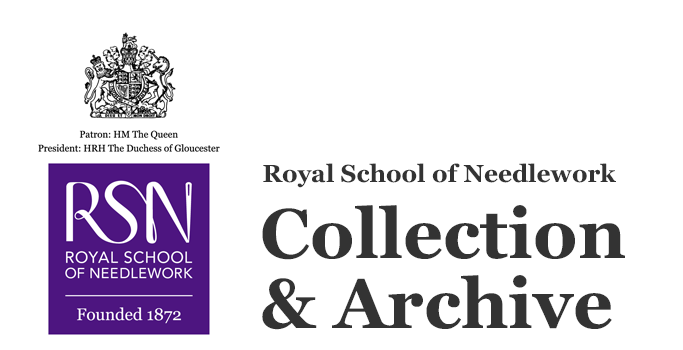Panel
Object name
Date made
Circa 1650s
Place made
Description
Circa 1650s casket panel depicting a dog chasing a doe through flowers and trees. Where once a dog's profile and a flower could be seen, now lie two holes cut out in a later century. The two circular pieces of fabric that were cut out were perhaps intended to adorn buttons, but remain unused and have been reunited with the panel.
Content description
This circa 1650s silk panel would have originally belonged to a small casket. The long, narrow panel is worked on cream-coloured silk satin in polychrome silk threads with the occasional silk-wrapped purl and passing thread also used. The scene depicts a dog chasing a doe through flowers and trees, both animals running across a series of five hillocks. The doe looks back at the pursuing dog. In between the dog and doe, in the centre of the panel, is a fruiting, leafy tree. Some small flowers grow from the hillocks, while larger fantastical flowers populate the panel's empty spaces. There are two clouds in the viewer's top right corner.
The panel retains brilliant colour, its pink and yellow tones still vibrant. Long and short, satin, and stem stitches are used throughout. French knots are used at the centre of the flower in the viewer's top left corner, while bullion knots can be seen in the flower to the right of the fruiting tree. This flower's stamens are made of passing threads. The flower in the right-hand corner has a centre of couched silk-wrapped purl and a border of narrow satin stitches. Underdrawing is visible throughout the panel, especially present on the dog.
There are two perfectly circular holes, 2.5 centimetres in diameter, which have been cut out of the panel at the dog's head and the flowerhead next to it. These two circles have been saved and now sit below the panel. Given the size of the circles, it is possible that they were cut out for use in adorning buttons. If this were the case, this would be a later intervention, likely dating to the 18th or 19th century. Though this is an appealing theory, there are no known examples of articles of clothing like waistcoats, jackets, and bodices that involve buttons taken from older embroidery. These two circles have been kept below the scene, protected by netting. The circles and the entire panel have been professionally conserved at the Royal School of Needlework by a Tutor, who has mounted the panel onto silk covered board and protected vulnerable areas of stitching with conservation net.
Embroidered casket panels of this sort were often made by teenaged girls as part of their education in mid to late seventeenth-century England. Casket panels were also made by professional embroiderers. Caskets and cabinets were tabletop boxes which contained secret compartments and held writing supplies, sewing supplies, perfumes, toys, and precious objects. It is very common for these kinds of caskets to illustrate hunting scenes.
The panel retains brilliant colour, its pink and yellow tones still vibrant. Long and short, satin, and stem stitches are used throughout. French knots are used at the centre of the flower in the viewer's top left corner, while bullion knots can be seen in the flower to the right of the fruiting tree. This flower's stamens are made of passing threads. The flower in the right-hand corner has a centre of couched silk-wrapped purl and a border of narrow satin stitches. Underdrawing is visible throughout the panel, especially present on the dog.
There are two perfectly circular holes, 2.5 centimetres in diameter, which have been cut out of the panel at the dog's head and the flowerhead next to it. These two circles have been saved and now sit below the panel. Given the size of the circles, it is possible that they were cut out for use in adorning buttons. If this were the case, this would be a later intervention, likely dating to the 18th or 19th century. Though this is an appealing theory, there are no known examples of articles of clothing like waistcoats, jackets, and bodices that involve buttons taken from older embroidery. These two circles have been kept below the scene, protected by netting. The circles and the entire panel have been professionally conserved at the Royal School of Needlework by a Tutor, who has mounted the panel onto silk covered board and protected vulnerable areas of stitching with conservation net.
Embroidered casket panels of this sort were often made by teenaged girls as part of their education in mid to late seventeenth-century England. Casket panels were also made by professional embroiderers. Caskets and cabinets were tabletop boxes which contained secret compartments and held writing supplies, sewing supplies, perfumes, toys, and precious objects. It is very common for these kinds of caskets to illustrate hunting scenes.
Dimensions
width: 24.5cm
height: 9.5cm
diameter: 2.5cm
height: 9.5cm
diameter: 2.5cm
Materials
Stitches
Motifs
Credit line
Gift of Edward and Jenny Woodruffe-Peacock, 2016.
Catalogue number
COL.2016.85
Other numbers
RSN 2223
© Royal School of Needlework

